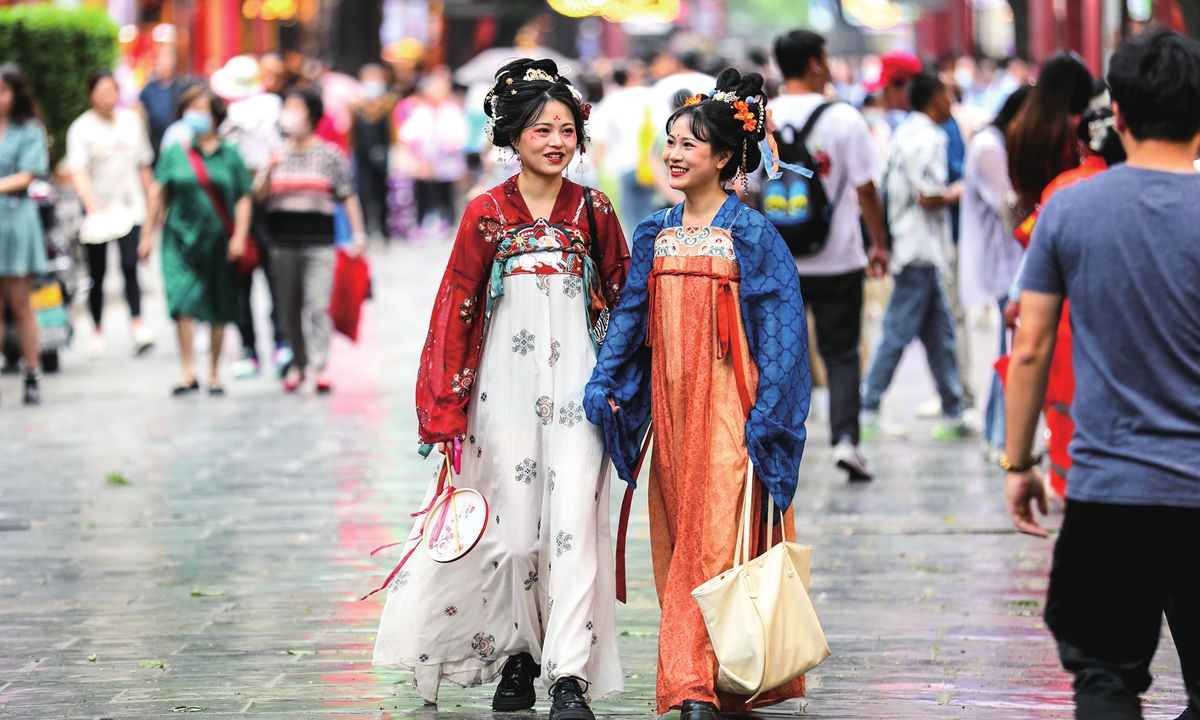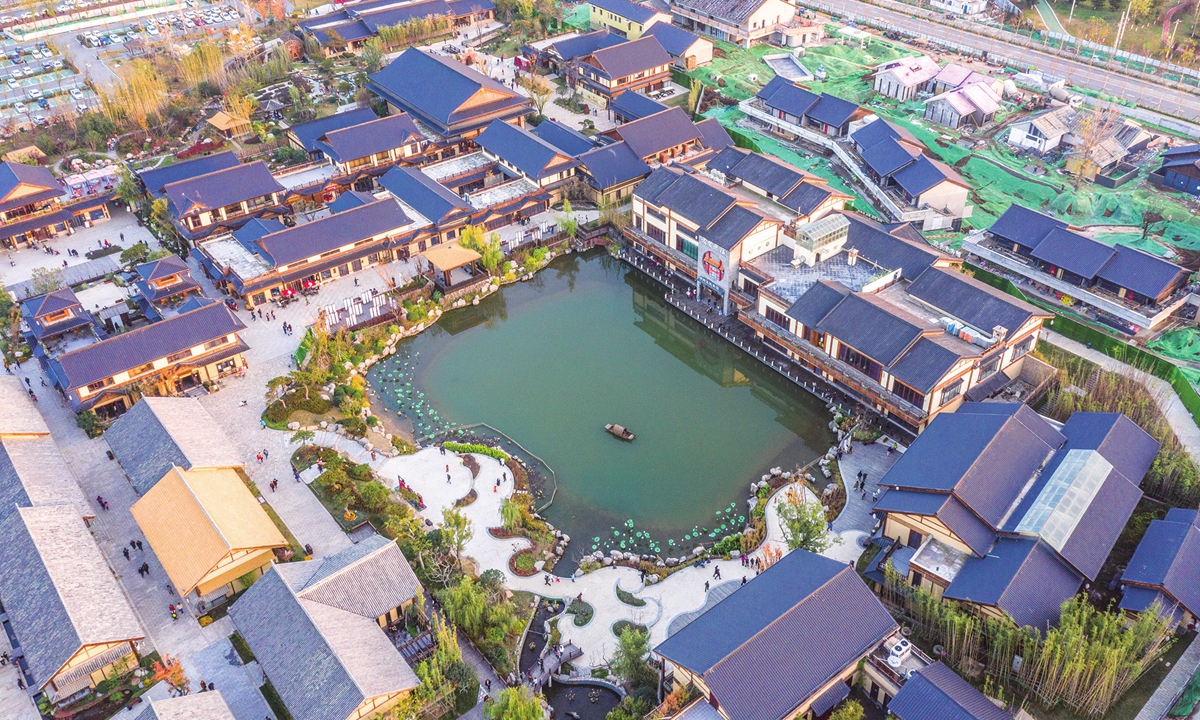
Two girls in traditional Chinese clothes walk on the street in scenic spot Great Tang All Day Mall in Xi'an. Photo: IC
In a period in which Tang-inspired dresses and costumes are increasingly popular, Xi'an, Northwest China's Shaanxi Province, a city with over 3,100 years of history, offers the feeling of real-world time travel through its history-inspired entertainment. At the end of May I decided to see it with my own eyes and I headed for the ancient capital of Tang Dynasty (618-907).
One night I set off to the city's famous tourist spot, Great Tang All Day Mall, which is a landmark pedestrian street with historic blocks for sightseeing, as well as trade and cultural facilities.
When I got off the subway, I noticed several small shops, offering passersby Tang-style costumes and make-up.
To my surprise, the shops were jam-packed with women, of all age groups. They went in wearing their vest and jeans, and came out donning exquisite and elegant Tang-style dresses and Tang Dynasty-inspired makeup: Peach-colored cheeks, well-drawn eyebrows, golden bird pins and a jade hairpin waving in the wind, known as
buyao in Chinese.
What's more, when they walked on the streets of Great Tang All Day Mall, in front of the newly built modern shopping malls, it felt very natural.
It was as if people from the Tang Dynasty period were walking the streets, naturally blending into today's modernity.
Other pedestrians did not pay special attention to them, as those girls walked slowly in their new gown, posing for pictures.
Wu, a girl in a pink dress and a peach blossom-shaped decoration on her forehand, told me that she had been wearing this kind of dresses all day long.
"I was dressed like this while I was touring the ancient wall and while eating in one of the famous food streets."
"This is part of Xi'an's immersive tourism that allows everyone to experience the best of Tang culture," said Wu.
Wu said that Western suits may look smart, but ancient Chinese clothes, like Tang-style dress, bestow an air of grandiosity and classical elegance on the wearer.
This kind of attire does not only fascinate women, on the contrary, while I was in the city, a number of men were wearing Tang-style clothes on the streets as well.
A 26-year-old tourist named Song Wen said he always dreamed of wearing such costumes since watching
The Longest Day in Chang'an. The TV series, shot in Xi'an, depicted the story of a former detective turned convicted criminal becoming Tang's last hope to thwart mysterious invaders who threaten the empire's capital city on the day before the Lantern Festival.

A small town built in ancient style located in Xi'an Photo: VCG
Ancient allureThe city is witnessing an increase in tourists, after the online historical drama became a hit among Chinese viewers.
The deep historical atmosphere has made Xi'an one of the most popular tourist spots in China in recent years. During the past May Day holidays, the city witnessed 13.3 million trips, and achieved a tourist income of 10.7 billion yuan ($1.5 billion).
Wu Rong, a Xi'an born and bred photographer, seized the opportunity and started a new business taking photographs for people wearing Tang-style dresses. In recent years, the streets in this area are full of people cosplaying as figures from the Tang Dynasty and shops provide both costumes and follow-up services, said the photographer.
Zhou Yi owns a shop 220 square meters in size at the Great Tang All Day Mall. She told me that, on average, her shop received 100 customers during the May Day holidays.
Zhou's shop has not only Tang-style dresses, but also other traditional dresses from a variety of Chinese dynasties, including historic Chinese clothing known as a
mamianqun, or horse face skirt.
Zhou said the shop owners, along with some fashion designers, sometimes hold ancient Chinese fashion shows in Xi'an, partly to appeal to potential customers and also to broadcast the beauty of ancient Chinese clothing.
"Only in recent years Chinese youngsters have begun to realize the beauty and delicacy of traditional Chinese fashion…I think such trend reflects the youth's growing cultural confidence," said Zhou.
Xi'an is rich in historical and cultural resources, such as the world-famous terracotta warriors and horses, the Bell and Drum towers, the ancient city wall and more.
The city counts a total of 159 museums, attracting over 30 million people each year, with 95 percent of its museums offering free entry for visitors to enjoy.
"With conservation as the guiding principle, we aim to breathe new life into our cultural legacy through artistic projects and multimedia displays, thus giving visitors a sense of rediscovery in China's ancient capital," said Sun Chao, director of Xi'an Municipal Administration of Culture and Tourism.
The cultural tourism sector has gradually become a pillar industry in Xi'an, where visitors can delve into history at the renowned Shaanxi History Museum, traverse the majestic ancient city wall, or savor the immersive experience of donning traditional Chinese attire.
"In Xi'an, every attraction reveals the profound nature of history, and every piece of music and dance performance tells of an ancient story. Whether one's passion lies in literature, history or food, everyone can find what they appreciate most in this remarkable place," said Liu Zhimin, another tourist from South China's Guangdong Province.





